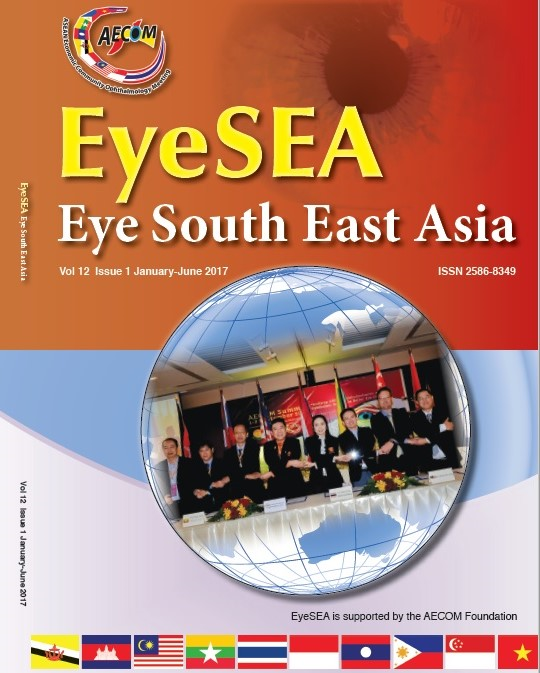Comparing the Effectiveness of Printed Versus iPad Ishihara Plates in Diagnosis of Congenital Red-green Color Deficiency in Thai Male Population
Main Article Content
Abstract
Objective : To compare the Effectiveness Between Ishihara plates on iPad Air2 and traditional printed standard Ishihara test for screening red-green color vision deficiency in male population
Design : Case-control Diagnostic Study
Methods : Male volunteers (patients and relatives) from Thammasat hospital and students from grades 3-6 at Buengkhaoyorn school, Pathumtani province were recruited. All volunteers were initially examined for red-green color deficiency by standard Ishihara test, and Pseudochromatic color test application in iPad Air2 at 100% brightness. 49 participants who had positive standard Ishihara test and 264 participants who had negative standard Ishihara test were asked to take the Pseudochromatic color test application on iPad Air2, comparing the two results to determine the latter test’s effectiveness in screening red-green color deficiency.
Results : A total of 313 selected volunteers were examined, age ranged from 6 to 80 years old. 49 participants who tested positive for red-green color vision deficiency using the Standard Ishihara test were also positive for red-green color vision deficiency using the Pseudochromatic color test application in iPad Air2. Another 264 volunteers who tested negative red-green color vision deficiency using the Standard Ishihara test also had negative red-green color vision deficiency using the Pseudochromatic color test application in iPad Air2. The sensitivity, specificity and positive predictive value for the Pseudochromatic color test was 100%, 100% and 100%.
Discussion : The Pseudochromatic color test is a suitable substitute to the standard Ishihara test when used on an iPad Air2 at optimal lighting conditions. The use of free standard Ishihara test substitute applications on tablets may be suitable for screening color deficiency in resource limited settings.Article Details
References
Abah ER, Oladigbolu KK, Samaila E, Gani-Ikilama A. Ocular disorders in children in Zaria children's school. Nigerian journal of clinical practice. 2011;14(4):473-6. Epub 2012/01/18.
Alabdelmoneam M. Prevalence of congenital color vision defects in Saudi females of Arab origin. Optometry (St Louis, Mo). 2011;82(9):543-8. Epub 2011/06/18.
Shrestha RK, Joshi MR, Shakya S, Ghising R. Color vision defects in school going children. JNMA; journal of the Nepal Medical Association. 2010;50(180):264-6. Epub 2011/11/05.
Sherpa D, Panta CR, Joshi N. Ocular morbidity among primary school children of Dhulikhel, Nepal. Nepalese journal of ophthalmology : a biannual peer-reviewed academic journal of the Nepal Ophthalmic Society : NEPJOPH. 2011;3(6):172-6. Epub 2011/08/31.
Niroula DR, Saha CG. The incidence of color blindness among some school children of Pokhara, Western Nepal. Nepal Medical College journal : NMCJ. 2010;12(1):48-50. Epub 2010/08/04.
Prevalence of red-green colour vision defect in students of Wat-KhunyingSomgene,Pathumthani
Alberta JT, Carel BH, Jan RP, Riet BB, Ingeborgh DB, and Caroline CK, Accuracy of Four Commonly Used Color Vision Tests in the Identification of Cone Disorders, Rotterdam, Netherlands
StataCorp. 2013. Stata: Release 13. Statistical Software. College Station, TX: StataCorp LP.


